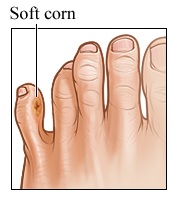If you are used to wearing tight or ill-fitting shoes, you are prone to develop soft corn between toes. These are like the hardened skin (corn) on top of your toes, but they tend to be red and tender with a thin and smooth center. Don’t worry. Even if they are irritating and painful, they are just your body’s way of protecting your feet from too much friction and pressure from your shoes. They may also develop due to moisture trapped in your shoes or due to the presence of bone spurs. However, since they are prone to infection, you must give them attention to prevent complications.

What Causes Soft Corn Between Toes?
Calluses and corns on your feet usually develop when you use ill-fitting shoes or high-heels, but they can also be due to improper walking. These put pressure on your toes and make you more likely to develop foot problems. Some people also develop soft corn due to the presence of foot deformities or wearing shoes and sandals without using socks, leading to increased friction on the toes.
Rubbing, friction or pressure causes skin to thicken and form corns and calluses. However, if you develop a thickening or irritation even if there is no source of friction or pressure, consult your doctor for evaluation. It may not be a corn or callus, but a wart or foreign body embedded under the skin.
Your feet are usually moist inside your shoes and this is an ideal environment for fungal or bacterial growth. Infection can develop when bacteria enter the soft corn through breaks in your skin, causing your infected skin to release pus or fluid.
How to Treat Soft Corn between Toes
1. Cleaning the Affected Area
First clean the area with warm water and mild soap. Rub off the top layer of the corn with a washcloth. Rinse your feet, then dry the toes using clean towel.
2. Medicated Corn Removal Pads
If scrubbing the corns is not enough to get rid of them, use medicated corn pads to remove them. These are available in most drugstores. Place the pads on dry skin. They will also cushion the corns and prevent them from rubbing against other toes, thus promoting healing. If you are using the non-medicated pads, apply salicylic gel on the toes before placing pads.
3. Chemical Treatment Containing Salicylic Acid
Chemical treatments with salicylic acid can help break down layers of dead skin on your corns and calluses. These are called keratolytic agents because they break down the keratin on your skin and cause the soft corn to peel off.
Medicated products may be available as drops, gels, creams and pads. Use them according to the manufacturer’s instructions. Ask your doctor about using them if you have circulatory system problems.
4. Being Pared by a Podiatrist
Another way to remove soft corns is to have them pared by a podiatrist. This helps reduce pressure and pain and can get rid of the corns. It is unlikely for your corns to return once you start using the right footwear.
5. Surgical Solution
Sometimes, corns develop due to bone spurs. These corns usually keep coming back and are very painful. They may cause a deformity on your toes and may require surgery to remove them permanently.
6. Antibiotic Ointment
If your corns become infected, they will become red and painful. Ask your doctor about using an antibiotic ointment to treat the infection.
7. White Vinegar
White vinegar is highly acidic and has antibacterial and antifungal properties. It is an excellent remedy for soft corn. Combine three parts of water with one part of white vinegar.Dab this onto your corns before going to bed. Cover with adhesive bandage then leave on overnight.
In the morning, exfoliate the skin with an emery board or pumice stone. Apply olive / coconut oil to keep corns moisturized. Do it daily until corns come out.
8. Turpentine Oil
If you want to use a strong antiseptic to treat soft corn between toes, try turpentine oil. It penetrates the skin quickly, promoting faster healing. First apply ice in a thin cloth on the area and massage for two minutes. Dry the area then rub some oil on your corn. Place a bandage and leave on overnight. Do this daily.
You can also use warm extra-virgin coconut oil mixed with turpentine oil and camphor oil. Use warm water to soak affected feet for a few minutes. Pat them dry and apply the oil mixture on the corn. Repeat this two to three times daily.
9. Cushion with Lamb’s Wool
Cushion your toes with a small piece of wool between toes and over the soft corns. Lamb’s wool is available in drugstores. This will help separate toes and prevent friction. Change lamb’s wool daily to prevent infection. Avoid using cotton because it may stick to your soft corns.
Note: Although home remedies may help removesoft corns, consult your doctor if they do not improve or if they become worse.
How to Prevent Soft Corn Between the Toes
1. Take Care of Your Feet
Using a scrubbing brush, wash your feet daily with water and soap. Dry your feet completely and apply a foot cream to rehydrate.
2. Wear Proper Socks
Use thick socks because they help absorb pressure on your feet. Make sure they fit loosely and that they do not make your shoes feel too snug. Use socks that don’t have seams because these may rub against corns or cause you to get corns.
3. Choose Comfortable Footwear
Wear properly fitted comfortable footwear. Shop for shoes in the afternoon when your feet are slightly swollen. When choosing shoes, make sure that you can move your toes inside, such that there is a small gap between your longest toeandthe front of the shoe. Avoid wearing high heels because they increase the pressure in the front of your feet.
